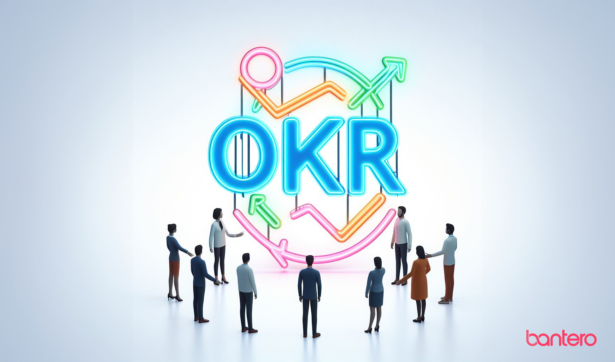Get started with OKRs
We are happy to offer 30 minutes of free OKR coaching to set you on track for your implementation!
Schedule 30m introSet goals like Google
Ever wondered what sets some organisations apart? Why do some companies succeed and others don’t? One common trait of successful companies is that they know where they’re headed and they have a clear path towards this goal.
OKRs (Objectives and key results) can offer you just this – a structured way to work with efficient goals in your organisation that will drive strategic alignment, focus and employee engagement. It has been around for more than 50 years and is used by organisations such as Google, the retailer Sears, the brewer Anheuser-Busch and many more.

The concept of OKRs is easy to grasp, while implementing OKRs in an organisation can be a challenging experience the first time.
OKR is in essence a smart set of rules on how to formulate high quality goals combined with a framework to set and follow-up on the goals you set.
Setting goals as OKRs
An OKR is a goal with two components, an objective (what we want to achieve) followed by 2-4 key results (how we measure that we have achieved our objective).
In OKR a key result never stands alone without an objective in the same way that you never have an objective without companion key results. This way we ensure that our goals always contain an inspiring, qualitative ambition (objective) as well as clear quantitative, ambitious key results to give our measurable definition of this ambition.
An example OKR for an organisation seeking strategic alignment can look like this:
O: Implement OKRs in our organisation to drive strategic alignment
- KR1: 80% of internal survey respondents can identify our top five strategic priorities for the year
- KR2: Increase number of teams using OKRs from 3 to 12
- KR3: All employees have undergone OKR training before 3/4
For an organisation pushing for growth through international expansion, an OKR could look like this:
O: Establish our business in Germany to drive international growth
- KR1: Grow monthly revenue in Germany from €1M to €2M
- KR2: Capture 5 new top tier German logos for our sales material
- KR3: Gain PR exposure to the equivalent of 3M impressions
The structure of an OKR and how you work with OKRs is based in goal setting theory, a science with focus on how to structure goals to make individuals and teams perform at their best.
Working with OKRs in your organisation
There are three types of OKRs:
- Strategic OKRs – crafted by management based in the organisation strategy
- Team OKRs – crafted by a team influenced by the organisations strategic OKRs
- Individual OKRs – individual performance goals
At each level (strategic, team and individual) it is common to work with 2-3 OKRs in parallel. With 2-4 key results each, this gives four to twelve key results to keep track of at a time per level.
Strategic OKRs are usually set yearly by the management team and fully based in the upcoming years strategy, budget as well as the vision and mission of the organisation.
Teams then set their OKRs quarterly (or at similar interval). The team OKRs are crafted by picking strategic objectives and key results based on what role the team has in the organisation (sales, marketing, development, …) together with OKRs constructed around the teams current challenges and ambitions (such as internal processes, recruitment, …).
Individual OKRs are not as common as they used to be, but where they are implemented they focus on the individuals contribution to the team OKRs and become a mix of objectives and key results from the team and personal development goals (such as professional training, performance improvements, …).
Strategic OKRs are usually followed-up on every other week with a larger summary and retrospective every three months. Team OKRs are followed weekly with a longer check-in mid-period and a retrospective at the end of the period. New OKRs are then crafted for the upcoming period.
Individual OKRs usually follow the team cadence for follow-up and conclusion.
OKR offer principles on the cadence of goal setting and follow-up, important pointers on how to craft the OKRs themselves as well as a lot of best practice to get the entire framework to work to your organisations advantage.
Why you should implement OKRs in your organisation
The structure and principles behind OKRs can give your organisation several powerful advantages if implemented right. The most prominent of these are,
- Strategic alignment – OKRs communicate strategy from management to teams and individuals which has the power to align entire organisations around the organisations common strategy.
- Focus – OKRs offer a clearly communicated focus to the organisation with accountability by measurable key results.
- Employee engagement – Team OKRs are influenced by strategic OKRs but crafted by the teams which brings ownership as well as accountability to teams and their members.
- Results impact – The structure of key results forces teams to identify the outcomes behind activities which many times leads to stronger performance.
- Strategy implementation – In the same way that OKRs bring strategic alignment, it is an efficient framework to deploy a new strategy into an organisation.
- Increased ambition – Key results should be ambitious stretch goals, yet achievable. This forces teams to push the boundaries for how things have previously been done and to start exploring new ways to reach their goals.
Above all, OKRs should drive your organisation forward in a clear direction and improve on the results on whatever you set out to accomplish.
/6 completed Getting started articles

Get started with OKRs
We are happy to offer 30 minutes of free OKR coaching to set you on track for your implementation!
Schedule 30m intro